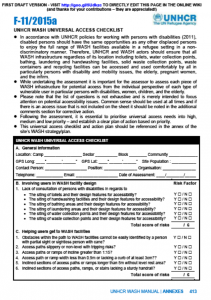
This document has been designed to help UNHCR and WASH actors assess WASH infrastructure for potential access from the individual perspective of each type of vulnerable user in particular persons with disabilities, women, children, and the elderly.
Tags: Accès pour Handicapés, Approvisionnement en Eau, Développement des Stratégies EHA, Douches, Évaluations EHA, Gestion de Programmes EHA, Installations pour la Lessive, Suivi et Evaluation EHA, Thèmes Transversaux, and Toilettes Communautaires. Languages: Anglais. Organisations: UNHCR. Categories: Directives Opérationnelles EHA, Documents de Référence EHA, Formulaires et Outils EHA, and Principes directeurs EHA.
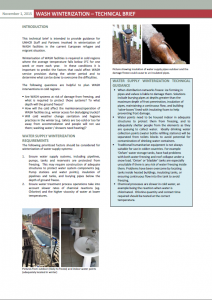
This technical brief is intended to provide guidance for UNHCR staff and Partners involved in winterization of WASH facilities in the current European refugee and migrant situation.
Tags: Approvisionnement en Eau, Climats Froids, Douches, Gestion des Excréta, Réseaux d'Adduction d'Eau, Sensibilisation à l'Hygiène, and Thèmes Transversaux. Locations: Europe, Europe Centrale et États Baltes, and Europe de l'Est. Languages: Anglais. Organisations: UNHCR. Categories: Directives d'Urgence EHA, Directives EHA, Directives Opérationnelles EHA, Documents de Référence EHA, and Principes directeurs EHA.
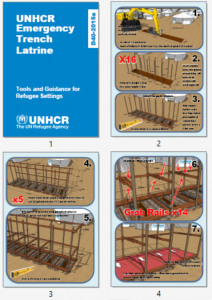
This document contains documentation to help UNHCR and WASH actors install emergency trench latrines (poles and plastic) in refugee settings. The package includes: Technical Drawings; Step by Step Construction Drawings; Bills of Quantity; Material and Workmanship Specifications; and Design Calculations.
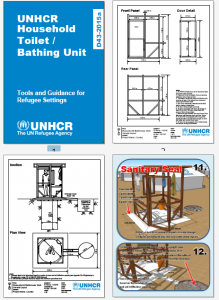
This document contains documentation to help UNHCR and WASH actors build household toilet and bathing units (domed slab) in refugee settings. The package includes: Technical Drawings; Step by Step Construction Drawings; Bills of Quantity; Material and Workmanship Specifications; and Design Calculations.
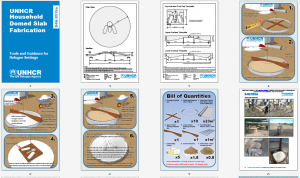
This document contains documentation to help UNHCR and WASH actors mass-produce circular domed squatting slabs in refugee settings. The package includes: Technical Drawings; Step by Step Construction Drawings; Bills of Quantity; Material and Workmanship Specifications; and Design Calculations.
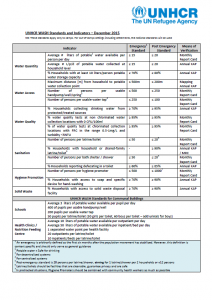
A summary of UNHCR water, excreta management, solid waste management, disease vector control and hygiene promotion standards and indicators for emergency and post emergency refugee settings including means of verification.
Tags: Approvisionnement en Eau, Contrôle et Suivi de la Qualité de l'Eau, Développement des Stratégies EHA, Douches, Écoulement des Eaux, Évaluations EHA, Gestion des Déchets Solides, Gestion des Excréta, Lavage des Mains au Savon, Lutte Antivectorielle, Sensibilisation à l'Hygiène, and Suivi et Evaluation EHA. Languages: Anglais. Organisations: UNHCR. Categories: Normes et Indicateurs EHA.
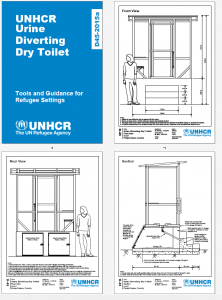
This document contains documentation to help UNHCR and WASH actors build urine diverting dry toilets (UDDT) in refugee settings. The package includes: Technical Drawings; Step by Step Construction Drawings; Bills of Quantity; Material and Workmanship Specifications; and Design Calculations.
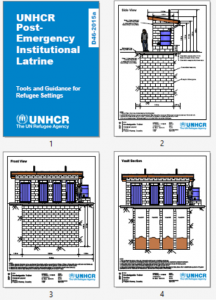
This document contains documentation to help UNHCR and WASH actors build desludgable institutional latrines in refugee settings. The package includes: Technical Drawings; Step by Step Construction Drawings; Bills of Quantity; Material and Workmanship Specifications; and Design Calculations.
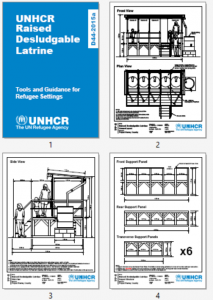
This document contains documentation to help UNHCR and WASH actors build emergency raised desludgable latrines in refugee settings. The package includes: Technical Drawings; Step by Step Construction Drawings; Bills of Quantity; Material and Workmanship Specifications; and Design Calculations.
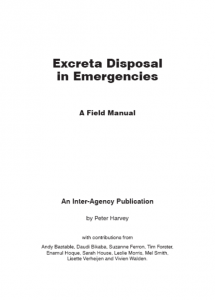
The purpose of the manual is to provide practical guidance on how to select, design, construct and maintain appropriate excreta disposal systems in emergency situations. Relevant situations include natural disasters, relief for refugees and Internally Displaced Persons (IDPs), and complex emergencies, focusing on rural and peri-urban areas. The manual presents a process, which can be followed to assess the current excreta disposal needs and priorities, and to design an
appropriate programme to respond to those needs. It can also be used to select appropriate excreta disposal technologies, systems, and hygiene promotion interventions. The manual provides guidance on how to plan, design and construct systems, and how to maintain and promote appropriate use of those systems.
 Français
Français










